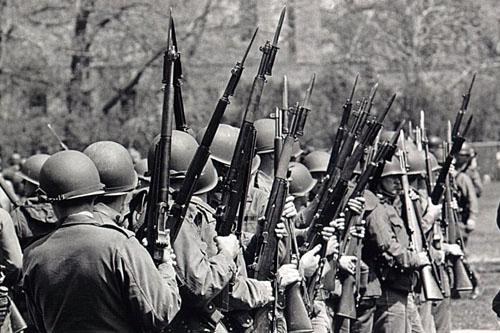|
Assignment American history in the 1960s and 1970s was wrought with turmoil and civil unrest as the nation was divided in a way not seen since the Civil War. As one looks at the events of this era, one major aspect stands out: the political activism of the young people on its college campuses - known as The Student Movement. Civil rights demonstrations and anti-war protests were prevalent on campuses across the nation as a gap between generations grew and old ideologies and traditional values were challenged. Oftentimes violence followed these demonstrations. No other event captures this truth more than that of the tragic shooting that took place in a little university town in Kent, Ohio in May of 1970. Assignment Explain which group(s) or individual(s) you feel played a significant part in causing this May 4th tragedy. What, if anything, could have been done differently to change the outcome of these events? Background The events which occurred at Kent State University in Ohio on May 4, 1970 have been listed as one of the catalysts that helped turn U.S. public opinion against the Vietnam War. What started out as a peaceful protest culminated into 4 days of unrest that ended in tragedy. During the Kent State Massacre (also known as the Kent State Shootings,) 4 college students were killed and 9 others wounded when the Ohio National Guard fired shots into a crowd during an anti-war protest on campus grounds. Although many of the details of events leading up to the tragedy were unclear, the affects on a divided nation shined brightly. President Nixon’s announcement on April 30, 1970, that American troops had invaded Cambodia as a means to attack the Viet Cong headquarters spurred dissent among anti-war demonstrators. Many Americans saw this invasion as a renege on promises made by President Nixon to end the Vietnam War. On May 1st, anti-war protests were held on college campuses across the country, and Kent State University was no exception; however, the disruptions that ensued that evening incited turmoil that outlasted the 4 days of turbulence. Sometime during that evening, a conflict at the local bars between police and protestors occurred with the result of protestors vandalizing local stores, banks and police cars, as well as starting bonfires in the streets of town. When Kent’s Mayor Satrom declared a state of emergency and ordered all bars closed and requested the assistance of the Ohio National Guard, the unrest grew. The trouble continued into the weekend as over one thousand protestors surrounded the ROTC building at Kent State University and someone set fire to the building. When protestors interfered with the ability of the firemen to fight the fire, the National Guard used tear gas and arrested protestors. As the intensity of the situation continued to grow, Ohio Governor Rhodes stated that he would declare a state of martial law. Although this declaration was never issued, both the university and guard assumed that the governor had followed through, and that the National Guard had control over the campus with all demonstrations prohibited. The turbulence peaked on May 4th, when 3000 people (approximately 1,500 demonstrators and 1,500 bystanders) gathered in the University Commons to object to the National Guard presence on campus as well as to the Vietnam War. As the National Guard tried to disband the crowd, discord grew with rock throwing and yelling as the guards were trapped on a field for approximately 10 minutes. Only after the guards returned to the top of a hill, "twenty-eight of the more than seventy Guardsmen turned suddenly and fired" their weapons. (Lewis and Hensley, dept.kent.edu/sociology/lewis/LEWIHEN.htm, 2006) "A total of 67 bullets were fired" in a time frame "that lasted only thirteen seconds." (Kent State shootings) Innocent bystanders were among the victims, with 2 of the 4 students killed being caught in the fire while walking to class. Although 8 National Guardsmen were brought up on charges in both criminal and civil trials, criminal charges were dismissed and a jury for the civil trial found that "none of the Guardsmen were legally responsible for the shootings" (Lewis and Hensley, 2006) due to their testimonies that they felt their safety had been threatened by the demonstrators. The State of Ohio ended further legal proceedings by settling out of court with the victims and their families, and the guardsmen issued a statement of regret concerning the incidents that occurred. The President’s Commission on Campus Unrest, which President Nixon established, "concluded that the Ohio National Guard shootings on May 4, 1970 were unjustified." (Kent State shootings). The
consequences from the tragic events affected not only Kent State University, which
closed for the rest of
the semester, but the country as well. It
caused a nationwide student strike which closed hundreds of colleges
and universities; it highlighted the need for law enforcement and military to
develop better ways to manage conflict between its citizens; but most
importantly, the events of May 4, 1970 at Kent State became a symbol of
political and cultural division in America "which occurred at the height of the
Vietnam War era." Please read my short interview with Mark Maedeker, a student at Kent State in 1970.  Student Protest at Kent State University Timeline Thursday, April 30th
Friday, May 1st
Saturday, May 2nd
Sunday, May 3rd
Monday, May 4th
Weeks following Monday, May 4th
1971
1974
January 1979
 National Guard Deployed at Kent State University Websites Pictures of Kent State (Eyewitness at Kent State), 1970 Some video clips: Dean Kahler, recorded in 2000 by WAOH and an audio documentary There are many other websites available with information about Kent State.
Books
Related Events |